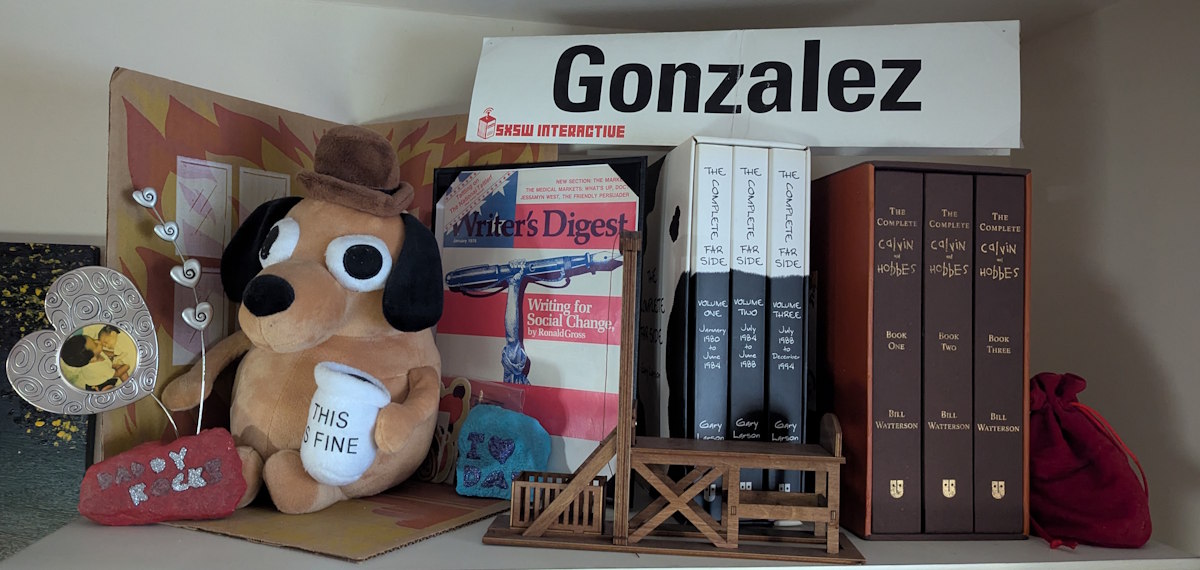This is my bi-weekly “newsletter” delivered straight to your inbox with at least one guaranteed typo I’ll catch after hitting send! If email collectors’ items aren’t your thing, don’t hesitate to switch to the RSS feed or just bookmark loudpoet.com and check in now and then. You do you!
NOTE: I’ll be at ALA this weekend for the day job; if you’re there, too, say hello. My son also starts shooting his film this weekend in our now unrecognizable garage, which I unfortunately won’t be around for. He just revealed his cast on his GoFundMe page, where he’s still raising money because even short films are ridiculously difficult and expensive to make.
_ONE
Social Media Replaced Zines. Now Zines Are Taking the Power Back | C. Brandon Ogbunu
Zines, meanwhile, are seeing a resurgence, popping up in museum collections and, in at least one instance, online comics. They are taking on new forms, modified by a generation seeking to make something that won’t go the way of Tumblr.
Every now and then I read something that sends me down a rabbit hole, but it usually means digging through my own blog archive, refining search results, or hoping the Wayback Machine remembers. This time, though, it was a couple of boxes I’ve had sitting around for years, full of my writing from the late-90s and early turn of the century, mostly from my poetry slam days. (It hurts to write that out loud, but it is what it is, old man!)
Before poetry, in the earliest days of the web, I was into zines. It was my second go at self-publishing after the newsletter for my high school fantasy football league, graduating from a Commodore 64, The Newsroom, and a dot matrix printer to a Compaq PC, Microsoft Publisher, and the office copy machine (after hours, of course). Instead of “reporting” on fake games between fantasy teams using real football players’ performances, I was basically blogging in print.
Mostly essays and short fiction, my first issue of zuzu’s petals — yes, named after a character in It’s a Wonderful Life, and yes, it included one of my favorite essays — played a huge role in meeting my future wife. The second issue (pictured here) included a “letter to the editor” from her, and we were married a year-and-a-half later — but that’s a whole other story.
I’d strongly argue that BLOGS replaced zines. Social media [almost] killed blogs by making it a little too easy for anyone to share their opinions on everything, which also made it harder to find the good stuff. That’s effectively what happened in my case as my interest in physical zines eventually shifted to chapbooks, and I only produced one more print issue of zuzu’s petals. I maintained its website a little longer (Compuserve!), but it’s sadly no longer accessible via the Wayback Machine.
(Almost 10 years later, Spindle was basically an online zine, too, but it was way more ambitious than I was able to sustain.)
Recently, I stumbled across Zines by Janine and realized zines didn’t have to be big editorial projects, and I’ve been inspired to think about making them myself again. I definitely plan to check out the Zine Pavillion at ALA this weekend for more inspiration, too. Maybe the next step is for someone to revive Factsheet 5?
__TWO
Inside Weird NJ: The Legends, the Lore, and the Men Who Made It a Movement | Salma Harfouche
Mark and Mark never set out to make a magazine. They just wanted to preserve the strange stuff that no one else was writing down. And somehow, in the process, they built a bible for the beautifully bizarre. So yeah, go ahead and scoff at the idea of haunted trees or cursed roads. But you’ll remember them, won’t you?
I’m from the Bronx and grew up in NYC, but Northern NJ was my second home from 1980, when I started spending every other weekend with my father in West New York, NJ. (No, that’s not a typo.)
Over the years, I moved back and forth between the two states (among other moves out of the area completely) before finally settling on the west side of the Hudson River in 2007, and I’ve been here ever since. Our kids grew up here and consider it home, which always felt weird because it took a long time for me to adjust to that fact. My core identity had always been tied to the Bronx and NYC, while Jersey was the goofy cousin I grew up making fun of, so I was initially disappointed when we realized leaving was our best option for getting them into schools that met their needs since we couldn’t afford to live in the right neighborhoods in NYC.
I don’t remember when I first heard of Weird NJ, but Harfouche’s zine-like ode to the Garden State’s signature magazine (which is still a zine at heart itself) gave me a new appreciation for both it and New Jersey, and I’m going to start diving into its archives over the summer.
___THREE
Why ‘authenticity’ is such a tough buzzword to replace | Jess Zafarris
That lofty notion of the genuine self or personal authenticity, being the “real you,” is a relatively recent twist, and it’s catnip for the internet age as users and organizations seek an antidote and antithesis to fake news, deepfakes and curated online personas. “Realness” is a prized virtue when performance, automation, misinformation and strategic obfuscation are the norm.
I hate most corporate and marketing buzzwords, but what I hate even more is perfectly good words getting hollowed out and becoming buzzwords, like authenticity. Zafarris does her etymology thing, highlighting the relatively recent definition of the word that is dangerously close to “literally” meaning its opposite, while also making a strong case for how to reclaim it.
I remain a fan of “authenticity” as an aspirational goal for individuals (hello, blogs! hello, zines!), and I admire companies who are able to demonstrate it with tangible actions. For me, an “authentic” voice can include typos and bad grammar as long as the message being delivered is clear and meaningful. Ironically, what so many people think they’re identifying as AI writing these days is often simply over-engineered writing by people who have forgotten what authenticity really means, or why it matters.
I definitely blame THAT on social media, algorithms, and vanity metrics!
____FOUR
The Missing 11th of the Month | David R Hagen
When I began this study, I was hoping to find a hidden taboo of holding events on the 11th or typographical bias against the shorthand ordinal. Alas, the reason is far is far more mundane: a numeral
1looks a lot like a capitalIor a lowercaselor a lowercaseiin most of the fonts used for printing books. An11also looks like ann, apparently. Google’s algorithms made mistakes when reading the11thfrom a page, interpreting the ordinal as some other word.
One of the things I still miss from the old blogging days is the serendipity of discovering new blogs, mostly through comments and links from other blogs, both of which took a backseat to social algorithms over the past decade, to the point where links are actively discouraged and comment sections are often a toxic minefield, if they exist at all.
Enter PowRSS, a cool tool from Pablo Enoc that features a lightly curated list of blogs, with a feed that’s updated daily with new posts from those blogs. My favorite feature is Random, which links you to a random post on one of the curated blogs and is how I stumbled upon Hagen’s fascinating post that I absolutely would not have found otherwise. Both are a perfect mix of deep nerdery and timely reminders of how important it is to know where your data is coming from, how it’s structured and tagged, and where the gaps might be.
_____FIVE
In America’s sandwiches, the story of a nation | The Conversation
We reached out to five food historians and asked them to tell the story of a sandwich of their choosing. The responses included staples like peanut butter and jelly, as well as regional fare like New England’s chow mein sandwich. Together, they show how the sandwiches we eat (or used to eat) do more than fill us up during our lunch breaks. In their stories are themes of immigration and globalization, of class and gender, and of resourcefulness and creativity.
Speaking of serendipity, I had this one saved specifically to combine with the bonus video below, but I can’t remember which came first, or how the hell I came across a 2017 article from a site I only became aware of last year! I follow The Conversation on Mastodon, so I’m guessing they coincidentally happened to resurface this article right around the same time YouTube randomly introduced me to Barry Enderwick and his delightful Sandwiches of History channel.
I’ve never given much thought to sandwiches beyond the “Is a hot dog a sandwich?” debate — Yes. — but I’ve been in the deep end the past couple of weeks. I now know that PB&Js used to be fancy, anchovy paste is way too much anchovy, and pretty much anything can be a sandwich if you have two pieces of bread and some imagination. I also have a new YouTube channel to enjoy, and maybe you do, too! My wife already owns several vintage cookbooks, some of which have sandwich recipes, but I’m tempted to get a copy of Enderwick’s cookbook anyway, along with his motto t-shirt, “Let’s Give This A Go!”
NOTE: My absolute favorite sandwich is a Reuben, corned beef or pastrami, and I regularly judge diners and pubs by how good, or bad, theirs is. Some places think piling on as much meat as possible is the way to go, but they’re usually wrong. Getting the balance of dressing and sauerkraut right is the real secret, no matter how much meat there is.
______BONUS
If you’re reading this somewhere other than your inbox and would like to get it via email, sign up here, or you can add the RSS feed to your favorite reader. You do you!
Do you like email?
Sign up here to get my bi-weekly "newsletter" and/or receive every new blog post delivered right to your inbox. (Burner emails are fine. I get it!)


